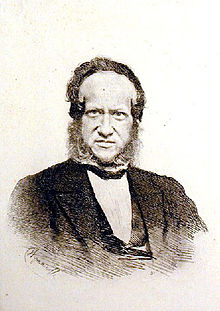Franz Josef Ruprecht
You can help expand this article with text translated from the corresponding article in German. (April 2012) Click [show] for important translation instructions.
|
Franz Josef Ruprecht | |
|---|---|
 | |
| Born | 1 November 1814 |
| Died | 4 April 1870 (aged 55) Saint Petersburg |
Franz Josef Ruprecht (1 November 1814 – 4 April 1870) was an
Life
He was born in Freiburg im Breisgau, and grew up in Prague, where he studied, and graduated as Doctor of Medicine in 1836. After a short period in medical practice in Prague, he was appointed curator of the herbarium of the Russian Academy of Sciences in Saint Petersburg in 1839.
In July and August 1841, together with a colleague, professor Sawelhaw of the Russian Academy, he organised and accompanied an expedition to the island to Kolguyev Island in the Barents Sea.[1]
He served as assistant director of the
He described many new plants collected in the Russian Far East, including Alaska, then under Russian rule; examples include Adiantum aleuticum, Lonicera maackii, and Phellodendron amurense.
Memorials
The genus Ruprechtia is named after him.[3]
Publications
- Ruprecht, F. J. Symbolae ad historiam et geographiam plantarum Rossicarum, St. Petersburg in 1846
- Ruprecht, F. J. Flora Caucasi, P. 1. St. Pétersbourg 1869
- Postels, A., Ruprecht, F.J. Illustrationes algarum, Weinheim, J. Cramer 1963
- Ruprecht, F. J. Flora ingrica (flora of the Leningrad region).
References
- ^ Trevor-Battye, Aubyn. (1895). Ice-bound on Kolguev, Constable, London, 1895.
- ^ Darwin Correspondence: Franz Josef Ruprecht
- ISBN 0-333-47494-5.
- ^ International Plant Names Index. Rupr.
- Extensive biography on Allg. Deutsche Biographie [1][permanent dead link]
- Fedotova A.A. The Origins of the Russian Chernozem Soil (Black Earth): Franz Joseph Ruprecht's ‘Geo-Botanical Researches into the Chernozem’ of 1866]], Environment and History, 16 (2010): 271–293
